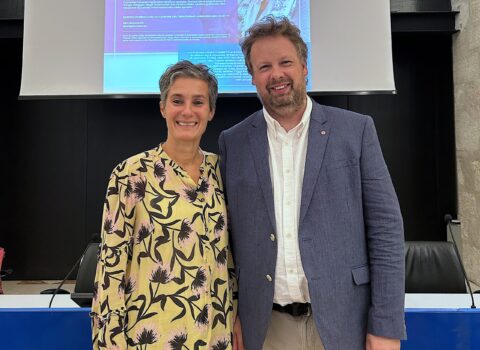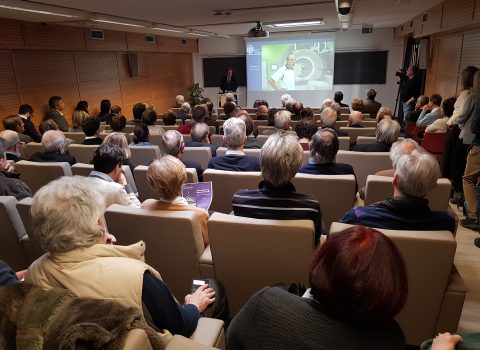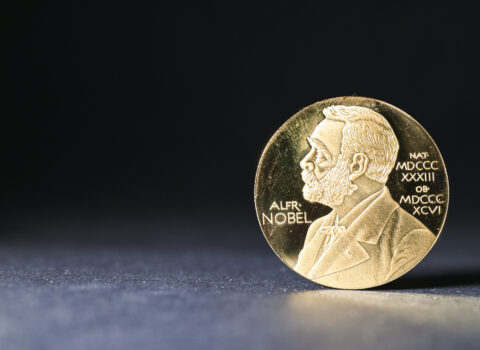
New smart bindings for the safety of skiers.
1,2 million from the Italian Fund for Applied Sciences for the four-year Blue Ski Research project go to FBK ECT* researcher Daniele Binosi.
On April 3, 2025, Italian ski champion Federica Brignone suffered a serious injury during the second run of the Italian Championships at Alpe Lusia (TN). She sustained a comminuted fracture of the tibial plateau and fibular head in her left leg, along with a torn anterior cruciate ligament —a frightening incident that could jeopardize her participation in the upcoming Milan-Cortina Winter Olympics.
In the face of accidents like this, Daniele Binosi’s project aims to enhance skier safety and reduce injury severity. How? By making ski bindings capable of recognizing dangerous situations in near real-time and triggering an emergency ski release—the key factor in many injuries.
The context
In recent years, safety in ski racing has improved significantly. In particular, the introduction of cut-resistant suits (mandated by the FIS in 2021) and, more notably, airbags for upper-body protection—made compulsory in downhill and Super-G World Cup events starting from the 2024–2025 season—have had a remarkable impact. However, these safety measures are not yet required during training sessions, which are no less risky than competitions.
Drawing on two decades of experience in other industries, leading ski manufacturers have developed airbags equipped with accelerometers, gyroscopes, and GPS. These sensors work together to monitor motion and automatically detect hazardous situations. The system processes data at a frequency of 1,000 times per second, allowing it to trigger precise and rapid protective responses across the chest area when needed.
However, lower body protection has lagged behind, particularly in the area of ski bindings, whose core technology has remained largely unchanged for many years. Swiss ski champion Marco Odermatt, a vocal critic of this stagnation, has repeatedly called for innovation in the binding sector. Odermatt, an Olympic gold medalist (Beijing 2022), three-time world champion, and four-time overall World Cup winner, highlights the urgency of updating the 20-year-old binding technology.
Genesis of the project
The idea behind Blue Ski Research (BSR) took root in Trentino in 2021, in collaboration with Massimo Canato and Christian Lorandi. Supported by local innovation and development agencies—Hub Innovazione Trentino and Trentino Sviluppo—the proposal was formalized in response to FISA call D.D. 1405 of 13/09/2022 (CUP: C63C24000250001). Binosi was awarded €1,206,280.74, and brought Dr. Giovanni Gerardo Muscolo (also from FBK-ECT*STAR) onto the development team. The BSR project officially launched on March 1, 2025, and will run until February 28, 2029.
The core concept is to algorithmically link the release of ski bindings to airbag deployment, leveraging the proven reliability of modern airbag systems.
The current binding prototype has a Technology Readiness Level (TRL) of 3 to 4 (proof of concept/validated in lab conditions). The BSR project aims to raise this to TRL 7 (prototype demonstration in an operational environment) within two years.
The new binding functions like a traditional one but releases non-destructively, making it reusable without maintenance. Though initially designed for professional athletes, the system could eventually benefit ski tourers and recreational skiers, improving safety across the board.
Project description
The project focuses on three main areas: The project is defined by three main elements. First, the development of a new generation of ski bindings. Second, the integration of connectivity features to ensure the device responds quickly and effectively. And third, the electronics and control software, designed to ensure the skis release only when necessary—avoiding premature detachment, such as during sharp turns by the athlete.
To identify a partner for engineering services, a call for expressions of interest was issued. The ProM Facility in Rovereto was selected.
In collaboration with ProM, the team is refining the binding dimensions to meet FIS standards and working toward an activation time of under 500 ms, ideally 50 ms, in line with airbag deployment times (35 ms). This synchronization ensures timely and coordinated protection.
Fun Fact: Binosi’s current research focuses on the properties of BOUND states—like protons and neutrons held together by three quarks. And… BINDINGS connect skis and boots. Moreover, the strong nuclear force is mediated by gluons, often illustrated as SPRINGS —a component also central to ski bindings. So, who better than Binosi to “tame” the strong force of ski bindings?





